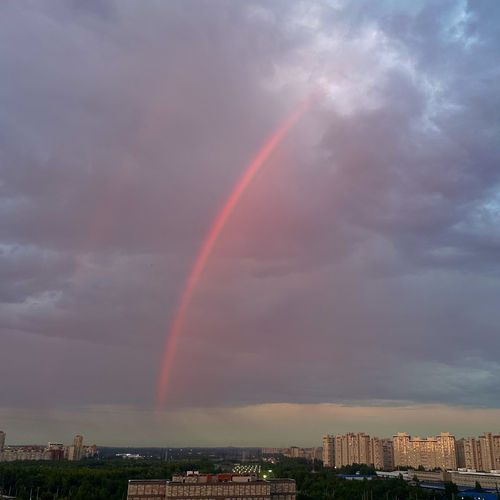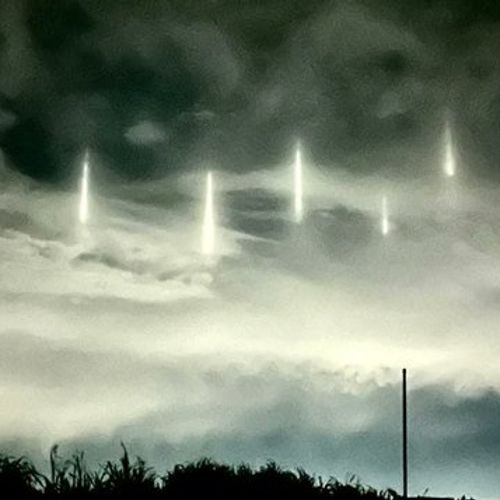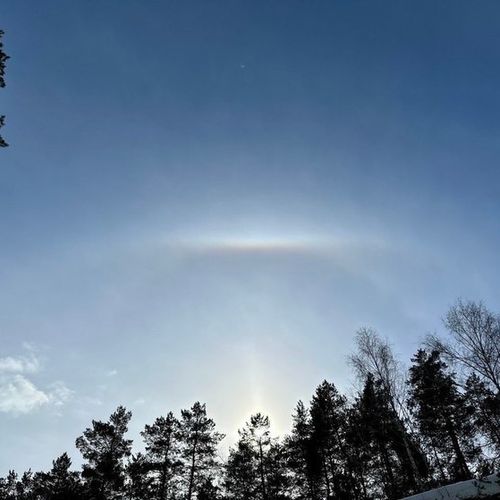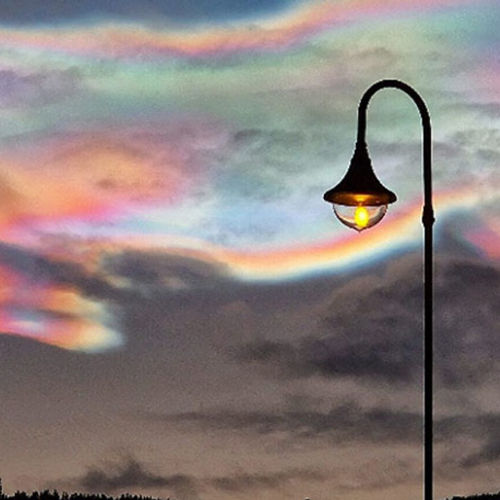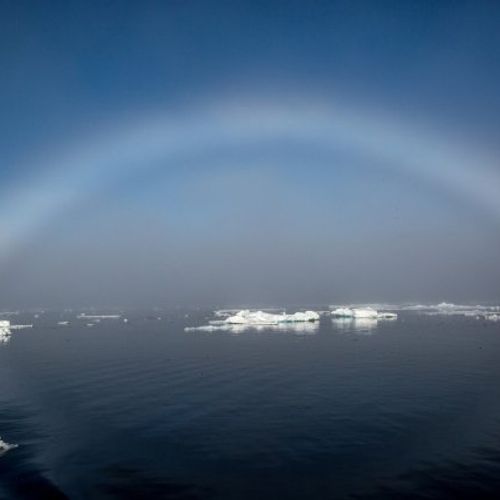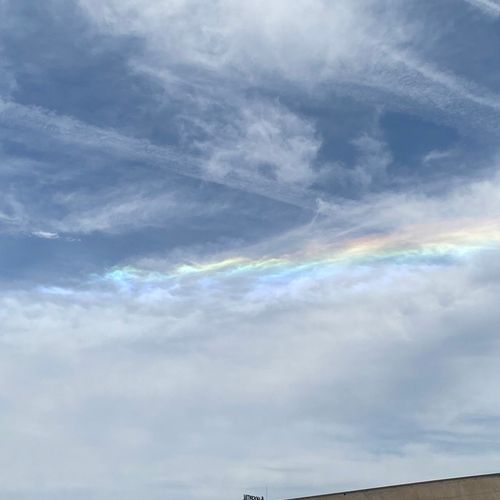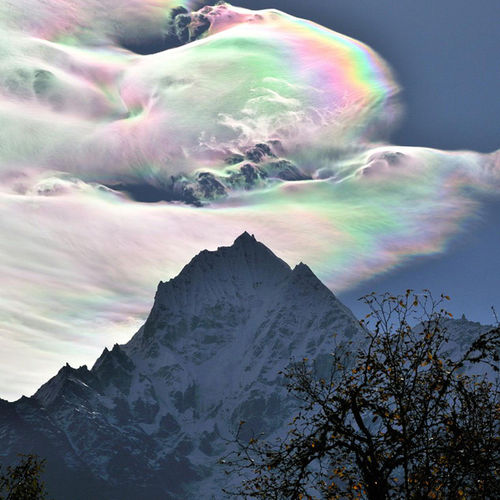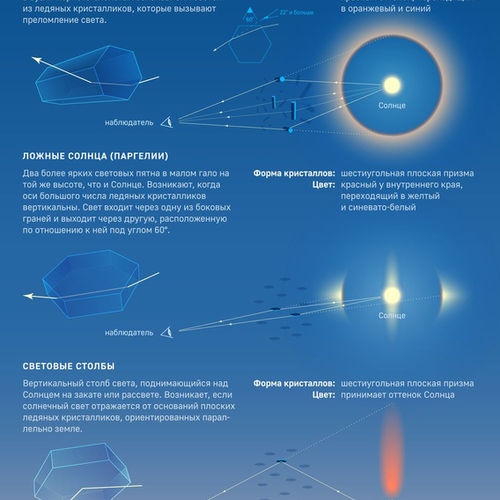
| Added | Sat, 29/01/2022 |
| Источники | |
| Дата публикации | Fri, 28/01/2022
|
| Версии |
In February, according to the forecasts of the Hydrometeorological Center, frosts are expected in Central Russia. This means that there are more chances to see such unusual atmospheric phenomena as halos, false suns and light pillars. When the air is saturated with ice crystals, they act like glasses, refracting or reflecting light with their facets. What happens depends on the shape of the crystals, their orientation in relation to the earth and the location of the light source.
When freezing, water droplets in the air turn into a crystalline form: the molecules line up in groups of six, so ice crystals are almost always hexagonal or hexagonal. The lower the thermometer column, the larger the crystals are obtained. At minus 20, snowflakes-plates form in the clouds. If the temperature drops even lower, oblong pencil snowflakes are already flying in the air.
Then it's up to the sun.
Halo
A bright halo around the sun, moon, as well as some stars, planets, lanterns and searchlights can be observed at any time of the day or night. To do this, there must be a layer of ice dust between the luminary and the observer. For example, when there are not very dense cirrus clouds in the sky (when dense, we will see only a slight glow). Unlike cumulus clouds, which are saturated with water vapor, cirrus clouds are icy. The halo can be seen in summer, but in winter it looks more spectacular.
To form a halo, the water in the cloud must be in the form of a prism. Passing through each piece of ice, the light is refracted, that is, it goes further not straight, but at an angle. Because of this, it seems to us that there are others around the main light source. When there are a lot of crystals and they are arranged randomly, a smooth glowing circle is obtained. And sometimes more than one. In rare cases, complex patterns of circles strung on top of each other appear in the sky. But a single halo can also be fascinating, especially when it sparkles with different colors.
When a light beam passes through an ice crystal, the light is not just refracted, but also decays into different colors. The same thing happens with a drop of water — that's why we see a rainbow after a rain or at a waterfall. But ice crystals are a denser medium than drops of pure water. Because of this, most of the colors of the spectrum are absorbed, and we see only red and yellow. The larger the crystals, the more regular they are, the brighter the circle glows. When the crystals are small and arranged randomly, the colors mix and the circle turns white.
Conditions for the appearance of halos often develop in winter during the transition from clear frosty weather to warmer and wetter. The air is still quite cold, but the sky is already covered with thin cirrus clouds. Beyond the Arctic Circle, where "diamond" dust from ice crystals is constantly present in the air, halos can be observed more often.
Pargelia, or false suns
These are also members of the "halo family", but they will have to be seriously hunted. They look like bright spots of light on the sides of the sun, often of uneven shape. They can be seen at sunset or sunrise when the sun is still close to the earth. Approaching the surface, ice crystals often line up in the same direction - vertically downwards to overcome air resistance. The thicker the cloud of crystals, the more powerful the flow of refracted light. This flow forms solar twins on the sides.
Why are parhelias a rarer phenomenon than halos? The fact is that the air is warmer closer to the ground. And for the formation of large crystals near the surface, tens of degrees of frost are needed. Such "gifts" usually bring with them anticyclones with cold frosty weather. They are more often observed in the North — in St. Petersburg, Petrozavodsk, Murmansk or Finland. About once a year or several years, it may appear further south (for example, in Moscow or Tver). But there, as a rule, the pargelia are more faded.
Pargelia can often be seen at the intersection of two halos — vertical and horizontal. The horizontal halo is called a parhelic circle. It is very rare to see it in its entirety. This phenomenon occurs when light is reflected from the vertical faces of ice crystals, which are almost evenly distributed across the sky.
PRECAUTIONS
Sunlight is too bright for the eyes — although it seems that in a diffused form it is softer. Therefore, it is better to observe the halo in sunglasses. It is most reasonable to choose high-quality glasses with a high level of protection from ultraviolet radiation. Looking at the halo, it is best to cover the sun with an object or, for example, with the palm of your hand. The same should be done when photographing this phenomenon. Otherwise, the image may not be clear enough.
At night, during the full moon, you can observe false moons - parceles. They also come in a reddish color, although it is difficult to notice with the eye. The light of the moon is much dimmer — it is not enough to excite the cones - the cells of the retina that are sensitive to color. The ideal conditions for a parcelena are a clear and frosty night.
Fire Rainbow
This is also a halo, but very unusual and not so widespread. It is formed when a light beam falls on the upper or lower part of the crystal, and exits through one of the side faces. When the light is refracted, it is distributed over the spectrum, as in a normal rainbow - a bright multicolored stripe is obtained. But to see it, several conditions must coincide at once.
Ice crystals should be relatively flat, not elongated, horizontally positioned, and the sun should be high enough in the sky (at least 58 degrees above the horizon). North of 55 degrees north latitude (and this is, for example, Moscow) or south of 55 degrees south latitude, you will not see it: the sun does not rise so high here.
It is better to go to the mountains for a fiery rainbow. Due to the fact that the rays have to travel quite a long way inside the ice, the dispersion very strongly divides the white ray into colored components, and the clouds really begin to blaze with all the colors of the spectrum.
Light poles
Sometimes at dawn or sunset you can see an elongated sunny path above the horizon — as if the sky were the surface of a transparent lake. When the sun is low and flat ice crystals are slowly falling in the sky above the earth, the light reflects off them like from a water surface. At sunset, the sun turns yellow, orange or red, and the pillar takes on the same shade.
The light column is best visible when the sun is slightly hidden behind the horizon, a house or a tree and does not illuminate the view. Sometimes at night in the city or near it, you can even observe a whole forest of light — due to the fact that the light is reflected from lanterns and other light sources. Such a "forest" is often multicolored because of the different colors of the lamps — bluish from mercury, yellow from sodium and green from neon.
To see such a phenomenon, it is better to dress warmly — the temperature should not be higher than minus 20 degrees. Most often it is observed in the northern countries - Finland, Norway, Sweden - or in Siberia and the Far North.
Новости со схожими версиями
Log in or register to post comments

